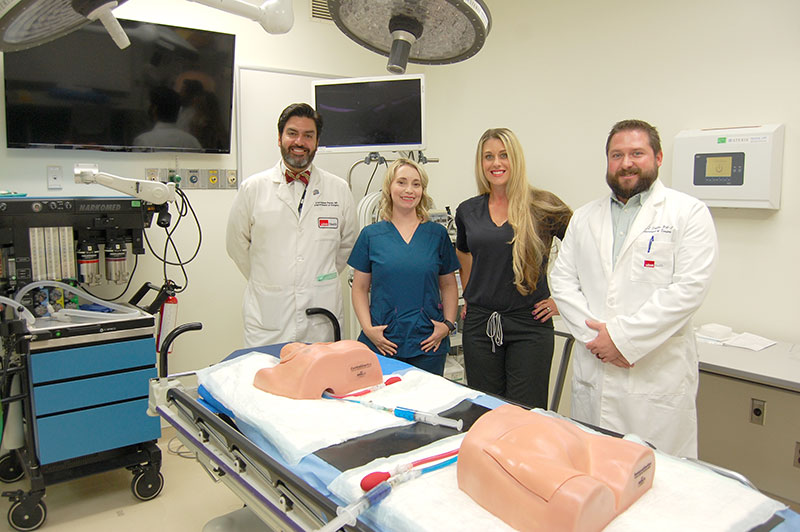Sealy and Smith Laboratory for Surgical Training, Assessment and Research promotes patient safety through state-of-the-art simulations

While continuous improvement through lifelong learning has been a key part of UTMB’s culture for years, this tenet comes to life at the Sealy & Smith Laboratory for Surgical Training, Assessment and Research (LSTAR).
In this modern workspace on the sixth floor of the UTMB Health Clinics building on the Galveston Campus, medical students, residents and practicing surgeons use simulations and virtual reality—among other methods—to practice procedures, learn new techniques and experiment with innovative technologies far from the high-stakes environment of the operating room.
“This training and this facility are central to UTMB’s mission with our focus on providing Best Care for our patients each and every time,” said Dr. Alexander Perez, surgical director of LSTAR and chief of the Division of Minimally Invasive and Foregut Surgery.
Perez said the simulation training is vital because it allows health care professionals to truly master a procedure or a surgical tool before it’s used in the OR, something that was unheard of a few years ago.
“In past years, it was see one patient, do one procedure and teach that procedure,” he said. “With simulation and the online learning tools available now, you could theoretically do one procedure a million times to master it before operating on a patient. This technology keeps patients safer and provides optimal learning conditions in a controlled environment for our health care professionals.”
The brainchild of Dr. Courtney Townsend Jr., the LSTAR was founded in 2006 and today is a national testing center for Fundamentals of Laparoscopic Surgery and Fundamentals of Endoscopic Surgery, distinctions that mean residents and faculty surgeons from across the U.S. visit, said Cliff Snyder, the lab’s education director.
But what makes the LSTAR particularly distinctive, Snyder said, is the lab’s emphasis on incorporating interprofessional education (IPE) principles into its simulations.
“Surgery is a high-stakes environment and it takes a team to make each surgery successful for our patients,” Snyder said. “So, we incorporate a team-based approach into our simulations. Even if we’re just conducting a random post-operative scenario, we’ll create a situation with a more critically ill patient to involve a respiratory therapist, an anesthesiologist, a nurse or a surgeon to name a few. We want IPE to be a part of our entire curriculum.”
The LSTAR team itself is a testament to interprofessional education. Dr. Perez and Snyder serve as directors while Shannon Delao, a surgical technologist with more than 10 years of operating room experience, is the lab’s coordinator, and Kristen Kahrig, a former researcher with UTMB’s departments of Internal Medicine and Anesthesiology, is the lab’s business coordinator.
And each team member is equally excited about the prospects of technology changing the way health care professionals will learn in the future and incorporate Best Care into their practice.
Perez said one of the developments that has him particularly enthusiastic is the advent of three-dimensional printing and its applications in simulation. 3-D printing will enable surgeons to create a replica of a patient’s anatomy so they can practice on that likeness as many times as necessary before entering the operating room, he said. LSTAR has developed a collaborative relationship with UTMB’s MakerHealth Space to create innovative training models via 3-D printing technology, such as simulated gall bladders.
“Some centers are already doing this type of modeling and simulation for complex surgical cases,” Perez said. “But what we’re talking about is applying this approach to the more common procedures, like a laparoscopic cholecystectomy (removal of the gallbladder through a small incision).
“Yes, practice like this makes sense in complex cases, but I believe it will help with everyday procedures too, because it reduces complications and poor outcomes. I believe this modeling approach is going to be the standard of care in the future."